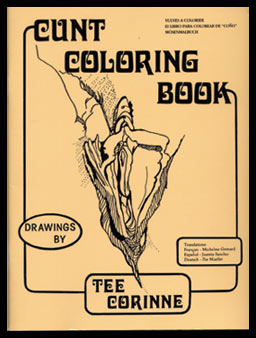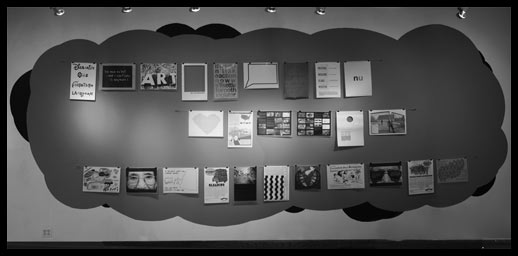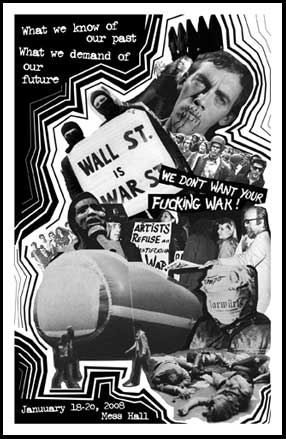 |
||
i love to we what we know of our past – What we know of our past-what we demand of our future was a threeday gathering at Mess Hall, in Chicago, from January 18th to January 20th in 2008. We co-organized the weekend with Ydre Nørrebro Kultur Bureau (YNKB) an experimental art space and group from Copenhagen. It was our hope to activate the continuum of past and present radical cultural production by drawing attention to the dialogical practices, political and socially engaged art, and sustainable living experiments of the 60s and 70s counter-culture movement and those working in comparable capacities today. We envisioned the weekend as an opportunity to put aside our more-or-less individual pursuits and to build collective resistance to deeply troubling larger problems and general malaise. The weekend was for sharing work, thinking about important historical activities, and finding a way forward that can sustain us and challenge the dominant culture.
The Library of Radiant Optimism was a starting point for organizing the gathering. The Library is as an archive and catalogue of a groundswell of optimistic and visionary activities of the late 60s and early 70s – books we collected that related to our own practice. We, Brett Bloom and Bonnie Fortune, had discussions off and on in the context of our respective practices, about the similarities between a handful of books we knew of, and Mess Hall – an experimental cultural center in Chicago that we both were active in for over three years. Mess Hall is organized around an “economy of generosity”; its freely shared culture, information and materials build a social model that is counter to the current exploitative environment created by the mandatory consumerism that shapes most of our interactions with one another. We see the books in the Library, written from a counter-cultural perspective by authors interested in communicating their direct experience of building sustainable communities, as important precursors to Mess Hall. How to Build Your Own Living Structures and Spiritual Midwifery were the first 2 books in The Library of Radiant Optimism. Books from our personal collections, they each described separate situations in which people took the time to learn a skill, through trial, error, reading, asking, and working with others – radical design, and home birth respectively – and then shared with others. Currently there are 21 books in the Library describing the results of research combined with the practical experience of grass roots exchanges of materials and information. One book, The New Alchemy Institute, can be described thusly, “a small group of artists, scientists, and thinkers concerned about the rapidity of the Earth’s destruction and the impending disintegration of social and moral values, joined together to form an organization with a name of peculiar significance for our time.” Another, The Cunt Coloring Book, a collection of black and white line drawings of close ups of various women’s genitals, states that the author, “liked the idea of combining a street term for genitalia with a coloring book, because both are ways that, as children, we get to know the world.” The books contain information both useful and strange, from homebirthing procedures, running a washing machine with a bicycle, experimental shelter building, alternative energy generation, independent media creation, sustainable farming techniques, how to build a child’s car seat from cardboard, what it means to be in a group marriage, how to build a house from garbage, how to organize a town so that one might see “old people everywhere” and va lot more. The books are fraught with the conflicts of personality and contradictory visions that still plague communities organizing for change today. Still, we remain excited by the complicated positions these books hold, and the possibility to glean knowledge from the experiments detailed in the books. Written with imperfect optimism, a willingness to put aside differences and work slowly on long-term projects shines through. The books, written in a time when many people were working together to re-make the world against an inherited bankrupt cold-war culture, provide a nuanced understanding of what could constitute a revolution. We wanted to call attention to all the hard work, visionary projects, and the continuity with creative activism happening today. In the interest of sharing the ideas contained in the Library, we produced various projects inspired by the books. Reading Tom Bender’s aphoristic environmental design philosophy book, Environmental Design Primer, we used his adage, “We seek a lower standard of living for a higher quality of life” to make a poster. Using designs in Nomadic Furniture as a starting point, we made lamps out of cardboard consumed in our kitchen, and provided detailed instructions for others to replicate this project. The book Radical Technology explains visions of autonomous communities with beautiful detailed illustrations. To activate this book, we took the illustration “Basement Vision #2” as our starting point and set up a screen-printing station in our basement. We also recreated the poster being worked on in the illustration “WHOEVER YOU VOTED FOR, THE GOVERNMENT GOT IN” to acknowledge similar feelings of discontent being felt in this election year and with the inherent problems in the disempowerment of electoral politics.
By re-making, re-performing, and re-producing these projects, there is the possibility of creating shifted consciousness that leads to larger change. A natural extension of these efforts to activate this rich history was coorganizing a 3-day gathering at Mess Hall with YNKB. YNKB is Finn Thybo Andersen and Kirsten Dufour Andersen. They have an interesting history that has helped shape both the library and our ongoing work together. They dropped out of the art world in the 70s to have a more direct revolutionary impact with their work. They were simultaneously inspired by Mao’s call to people to return to the land, Alan Kaprow’s ideas about non-art, and the burgeoning experiments of land art and earthworks. These multiple influences led them to move to northern Denmark and initiate large rag picking projects, along with fundraising initiatives that helped to support groups fighting for Eriterian independence. Finn and Kirsten maintain this history as a successful experiment in connecting art and activism. They returned to the art world in Copenhagen in the 90s. Finn and Kirsten provide a unique perspective on the directions taken in organizing the Library of Radiant Optimism. Through discussions with them around their histories, we organized two poster exhibitions with accompanying gatherings. These took place first in Copenhagen then at Mess Hall in Chicago. What we Know of Our Past, What We Demand of Our Future, took place in both Chicago and later in Copenhagen. Our current anxieties about environmental devastation, gas and food shortage, and an unjust war, are paralleled in the cultural and political climate of the late 60s and early 70s. However, we feel that an important difference between then and now is in the absence of a massive collective counter-cultural movement for change that people could readily identify with. We are interested in the possibilities that could be achieved with collective organizing and creative projects. Having been a part of and aware of several larger conversations happening across the country amongst fellow activist/artist folks, we needed to come together, to do something…anything. At the time of those conversations many people felt a crisis within their work–that it somehow was not doing enough, whatever it was supposed to be doing. This was a perfect time to come together, share what we were all up to, and to begin to really talk about what we do and how it might not be achieving what we want it to.
For the weekend at Mess Hall, we organized talks, presentations, meals, and group discussions over 3 days. Artists and cultural workers presented their work and research on issues ranging from environmental studies, prison education projects, queer utopias, and food democracy. The backdrop for the presentations was an exhibition of books from the Library, posters from the Just Seeds collective’s Celebrate People’s History poster project and masks of queer radicals both living and dead from the Summoning a New Queer Reality project by Chances. The presentations, by more than 30 artists and activists from the United States and Denmark followed somewhat the theme of drawing connections between past and present counter-cultural activities. Pressed into the small storefront of Mess Hall, we shared food and listened intently over 8-hour days to presentations. The weekend began with artist and researcher Nicolas Lampert talking about peoples’ history of art in the U.S. His talk explored the complicated history of the Paterson Pageant, staged at Madison Square Garden, in New York, on June 7th, 1913 by 1,000 striking workers, playing the roles of themselves as they reenacted their experiences with their particular struggle. Lampert posited the positive and negative aspects of the collaboration between striking silk workers, I.W.W. union leaders and New York avant-garde artists. Artist Ryan Griffis of the Temporary Travel Office spoke about environmental devastation and its relationship to ongoing racial inequalities, in Florida. The groups Material Exchange and Feel Tank presented on their experiences in organizing and redirecting waste produced by cultural events across the city of Chicago. We heard reports from AREA magazine, Mike Wolf, Nicolas Brown, and the Allium Collective. The Cheap Art for Freedom Collective [aka: Collective Anarchist Freedom Fuckers] (CAFF) encouraged folks to participate in an artist residency program in Salinas, California, at an exciting, highly experimental homeless shelter with its own collectivelyrun print shop. Laurie Palmer explained her long-term research into the environmental effects of various kinds of resource extraction. People Powered talked about their explorations of mobilizing people on an everyday level to creatively deal with the excess materials they produce through consumption. The art group Parfyme showed a large number of images of their playful ways of handling cast off material, blending it with social concerns, and opening up public spaces to new kinds of uses. Jakob Jakobsen, of the Copenhagen Free University, which had recently de-institutionalized itself, gave a talk about the use of militant actions in a struggle over an autonomous youth-led social center–Ungdomshuset–in Copenhagen. Artists and activists Sarah Ross and Laurie Jo Reynolds spoke about two different projects relating to prison issues. Food related projects were critical to the weekend. Food production and supplies were central to the presentations by Michael Rakowitz, Claire Pentecost and a group of Chicago based art historians and administrators: InCUBATE (Institute for Community Understanding Between Art and the Everyday). Michael Rakowitz gave a particularly moving presentation of his projects Enemy Kitchen and Return, describing the emotional and political terrains of food access and distribution. Both projects look at the war in Iraq starting from Rakowitz’s personal familial relationship with food distribution and preparation, but quickly moving to larger emotional and political issues. Rakowitz, whose family is Jewish and was forced to leave Iraq many decades ago, prepared an Iraqi dish that was served during the portion of his talk about Enemy Kitchen – an ongoing look at countries, by ways of food, that are depicted by the U.S. as deadly enemies, specifically the countries that make up Bush’s “Axis of Evil.” Claire Pentecost discussed her research on international food production policies and the living conditions of food workers in China. InCUBATE presented their Sunday Soup project, which invites an artist to make soup one Sunday a month, which is then sold as a fundraiser for a grant program that gives small sums of money to artists to realize projects. Those that make and purchase the soup choose who becomes the grant recipient at the end of each month. The multitude of diverse projects and presenters was both exciting and overwhelming. The weekend did show that many artists and activists are creating beautiful and engaging projects, but there was also the feeling that our art projects seem to have atomized our efforts. We didn’t have any good way of addressing this, and when we brought it up, it was met with silence, or hopeful apologies that “yes, indeed, we were all doing great things and we shouldn’t beat up ourselves about it.” On one level it was enough to come together, to see and acknowledge each other’s continued struggle and on another as we looked around on the last day of the symposium, there was an energy in the air. We asked, “What will happen now? What will we do?” No one, including us, wanted to start another group that would require meetings and overtaxing our already overtaxed lives. But, we have to ask, “What could we do with the energy that is generated by coming together?” We would like to see new formations happen beyond individualized (and this includes individual collectives) projects and careers. For us this is at the heart of the problem, and we do not have good ways of addressing it. New questions need to be asked, and one could sense this, but having the courage to do it openly and productively didn’t happen on the last day. We have in part been forced to exist on this level – as consumer-citizens divided into our own sets of personal preferences for the lives we consume. We also have internalized this individuation of our resistant practices and this is holding us back from making larger, stronger resistance and for thinking new possibilities for our existences. Exciting things came out of the weekend, things that could not have been planned for. We have organized, with a group comprised of former Mess Hall participants, folks who gave presentations during What We Know of Our Past-What We Demand of Our Future, and others, to identify and promote solidarities and support networks across the Midwest region. We are all calling it the Radical Midwest Culture Corridor, or the Midwest Radical Culture Corridor, or the Corridor of Midwest Radical Culture, and multiple other permutations. During the month of June 2008, a group of artists and activists connected activities in various cities and rural spaces, from central Illinois northward through cities and towns, ending in rural Wisconsin. We are interested in building networks beyond cities, developing an attention to local food production, strategies for visualizing resistance where we live, and in general making stronger connections between those who dissent and try to productively re-make the world around them. References | ||


